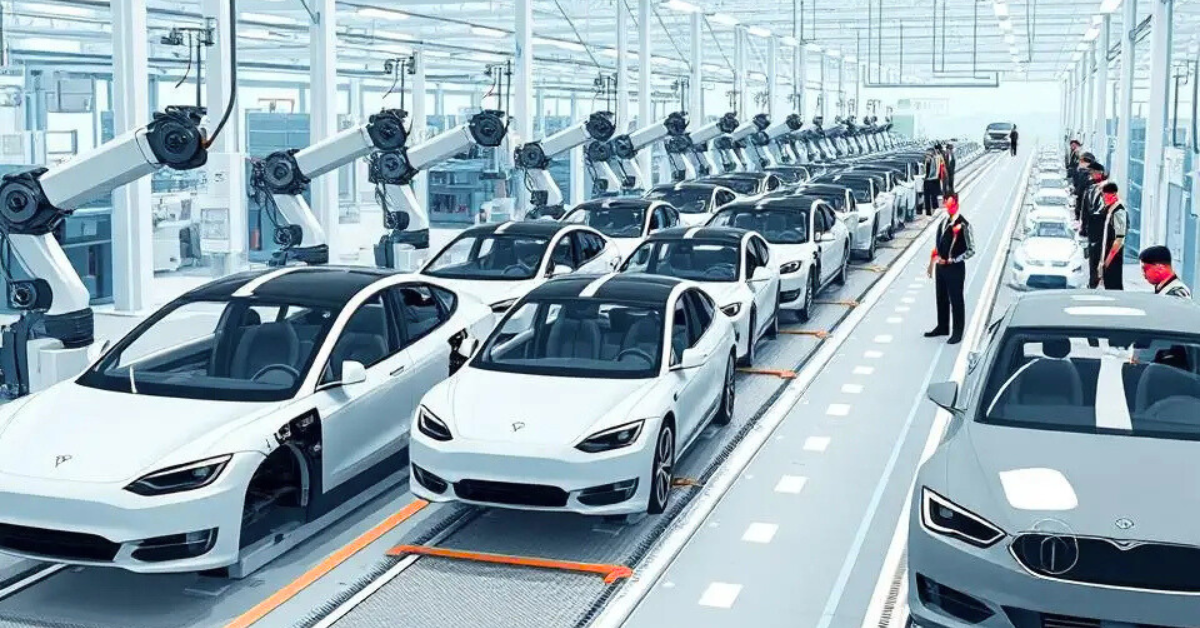Table of Contents
🚗 1. Exploding Market Potential & Domestic Momentum
India’s EV market is moving rapidly. As of 2025, EV sales reached approximately 1.52 million units, up 49% year-on-year, while the market was valued at ₹₹3.21 billion in 2022 and is projected to jump to US$114 billion by 2029 .The battery segment is also growing fast—from US$16.8 billion in 2023 to an expected US$27.7 billion by 2028 ibef.org. While EVs still represent a small share (≈ 2–6%) of India’s total auto sales, this growth trajectory is clear en.wikipedia.org+29spglobal.com+29spglobal.com+29.
Distinguishing sectors include two- and three‑wheelers, which fuel much of the domestic EV surge. For instance, India witnessed over 400,000 e-rickshaw registrations in Uttar Pradesh alone—where EVs now make up over 100,000 sales per quarter, supported by strong state policies .

2. Industrial Strength: Manufacturing & Investment
– Component & Vehicle Production
India has leveraged the Production Linked Incentive (PLI) scheme to attract large-scale investment in EV and component manufacturing. Since 2021, 257 EV-focused facilities across 17 states have been approved—led by Maharashtra (77), Tamil Nadu (46), and Gujarat among others Major automakers are well-positioned: Tata Motors (72% market share), Mahindra, Hyundai, MG, Stellantis, BYD, and VinFast have set up plants—particularly in Gujarat’s Sanand, Tamil Nadu’s Thoothukudi, and UP en.wikipedia.org+1itdp.in+1.
For example, VinFast is building a 150,000-unit capacity plant in Tamil Nadu operational by June 2025, with plans for charger networks and battery plants en.wikipedia.org. Meanwhile, Gujarat draws substantial investments—Halol hosts MG, Sanand hosts Tata battery cell production, and Vadodara is home to two-wheeler manufacturers like Wardwizard en.wikipedia.org+1economictimes.indiatimes.com+1.
– Domestic Supply Chain
India is rapidly expanding its battery and component output. Projects like Tata’s ₹1.58 million battery giga-factory in Sanand (20 GWh initial, expandable) and Wardwizard’s 1 GWh Li-ion cell plant in Vadodara showcase the booming domestic ecosystem en.wikipedia.org+1india-briefing.com+1. A national ACC battery PLI (US$2.1 billion) and automotive PLI (US$3.1 billion) further support full-scale local value chain development
3. Policy Framework & Strategic Incentives
– Central Incentives
The FAME II scheme alone allocated ₹10,000 crore (~US$1.4 billion) to support e‑buses, e‑three‑ and e‑two‑wheelers, and e‑passenger vehicles . The 2025–26 Union Budget increased automotive scheme funding by 74%, including ₹4,000 crore for PM E‑Drive charging infrastructure The government also reduced GST on EVs to 5% and cut battery and charger import duties—broadening tax relief to batteries, scrap, critical minerals, and capital goods financialexpress.com+1spglobal.com+1.
– State-Led Investment
Proactive states create favorable climates. Gujarat’s EV policy provides up to 25% capital subsidy, 90% SGST reimbursement for a decade, and interest support savills.in. Uttar Pradesh offers purchase incentives (₹5k–₹1 lakh), full road tax waivers, and dedicated land for manufacturing . Tamil Nadu, Karnataka, Maharashtra, Haryana, and MP also offer stamp-duty waivers, electricity duty exemptions, and land subsidies savills.in.
4. Scaling Charging Infrastructure
A vibrant EV ecosystem hinges on charging access. India increased public charging points from 12,000 in early 2024 to over 25,000 by November 2024, largely in Karnataka, Maharashtra, and UP ft.com+7inc42.com+7itdp.in+7. The PM E-Drive infrastructure scheme (₹2,000 crore) and ultra-fast networks by Hyundai, Torrent Power, Adani, Reliance are expanding highway and urban charging options inc42.com+1itdp.in+1. To match projected EV growth, the Confederation of Indian Industry (CII) estimates installing 1.3 million public charging stations by 2030, requiring ~400,000 new annual installs .
5. Private Sector & New Entrants
India’s EV value chain thrives on its start-up fabric—over 500 EV-focused startups, with 63% devoted to manufacturing mag.theasset.com+21marketsandata.com+21financialexpress.com+21. Prominent players like Ola Electric, Ather, Simple Energy, Revolt, Okinawa, EKA Mobility, Wardwizard, and Blusmart secure venture funding and grow capacity marketsandata.com+1en.wikipedia.org+1. Their product suites range from electric scooters to trucks and buses. Meanwhile, incumbents like Tata and Mahindra push for EV-only fleets in government procurement—advocating zero-emission fleets over hybrids reuters.com.
6. Challenges Ahead & Roadmap to Global Hub
Despite strong momentum, hurdles remain:
- High upfront costs: EV prices are still 20–30% above internal-combustion options—though narrowing spglobal.com.
- Financing constraints: Consumers and fleet operators struggle with access and affordability—calling for better credit systems .
- Infrastructure gaps: Coverage remains uneven across Tier‑2/Tier‑3 cities and highways .
- Regulatory clarity: Some state policies are nearing expiration, risking investor confidence spglobal.com.
However, with 140% year-over-year production growth projected in 2025 (to 301,400 passenger EVs) spglobal.com, and global giants like Mercedes, VW, Hyundai, Kia, BYD, and VinFast committing to local manufacturing , India’s electric transformation is on solid ground. The Tesla vs policy headlines show India’s bigger narrative: companies wanting manufacturing footprint—not just sales outlets—will benefit.
✅ Conclusion
India boasts:
- ¡Strong policy momentum, with bold tax incentives and budget boosts
- ¡Expanding manufacturing & component ecosystem via PLI/FAME/PLI battery
- ¡Rapidly growing charging infrastructure
- ¡Dynamic start-up energy and global OEM interest
Addressing cost, financing, and uneven infrastructure will finalize India’s leap into a global electric vehicle powerhouse. If current policies and investments continue, India is poised to host multiple EV gigafactories, a vibrant supply chain, and an increasingly EV-friendly consumer base over the next decade.
Also Read :https://latestindiannews.com/pakistan-water-crisis-dry-till-2040/

[…] https://latestindiannews.com/india-on-becoming-ev-hub-by-2028/ […]
[…] https://latestindiannews.com/india-on-becoming-ev-hub-by-2028/ […]